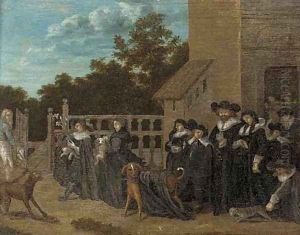Barend Fabritius Paintings
Barend (or Barent) Fabritius was a Dutch painter born in Middenbeemster, a small town in the Netherlands, in 1624. He was a member of the Fabritius family, a notable artistic dynasty in the 17th century. His older brother, Carel Fabritius, is by far the most famous of the siblings, known for his work in the Delft School and as a pupil of Rembrandt. Despite being overshadowed by his brother’s significant legacy, Barend developed his own artistic career and contributed to the Dutch Golden Age of painting, specializing in portrait and genre painting as well as biblical scenes.
Barend initially trained under his brother Carel and later worked in Amsterdam, Leiden, and Hoorn. His early works show a strong influence from Carel, both in technique and subject matter, with a keen focus on the play of light and shadow, a characteristic he adapted from Rembrandt through Carel’s teachings. After Carel’s untimely death in 1654, Barend’s style began to evolve, showing more personal interpretation and less influence from his brother's and Rembrandt’s styles.
In 1656, Barend became a member of the Guild of St. Luke in Delft, which was a significant milestone in his career, marking his acceptance and recognition among his peers. His work from this period onwards includes a variety of subjects, including portraits, peaceful domestic interiors, and church interiors, showcasing his versatility as an artist. His portraits are particularly noted for their sensitive depiction of the subjects, capturing not just physical likeness but also a sense of the person’s character.
Despite his talents, Barend never achieved the same level of fame as his brother Carel or his mentor Rembrandt. However, his contributions to Dutch art have been re-evaluated over time, and he is now recognized for his role in the development of 17th-century Dutch painting. His works are held in several prestigious collections and museums, highlighting his skill and the subtle yet distinct style he brought to the Dutch Golden Age.
Barend Fabritius died in 1673 in Amsterdam. His legacy, though quieter than that of his brother, endures through his paintings, which continue to be studied and appreciated for their craftsmanship and place in the history of Dutch art.
